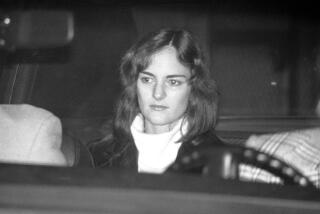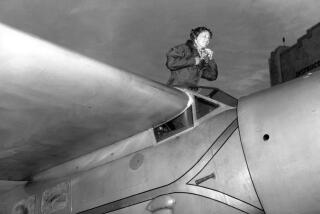A New Take on Earhart Mystery
Amelia Earhart vanished nearly 70 years ago, but her fate remains one of the nation’s great mysteries.
The pioneering aviator disappeared on July 2, 1937, as she was flying an equatorial route around the globe. The official U.S. position is that she and her navigator, Fred Noonan, ran out of gas and went down in the Pacific.
For the record:
12:00 a.m. Nov. 26, 2003 For The Record
Los Angeles Times Wednesday November 26, 2003 Home Edition Main News Part A Page 2 National Desk 0 inches; 28 words Type of Material: Correction
Amelia Earhart -- The Then and Now column in Sunday’s California section said that Earhart had planned to stop at the Hawaiian island of Niiahu. It is Niihau.
For The Record
Los Angeles Times Sunday November 30, 2003 Home Edition Main News Part A Page 2 National Desk 0 inches; 31 words Type of Material: Correction
Amelia Earhart -- The L.A. Then and Now column in the Nov. 23 California section said that Earhart had planned to stop at the Hawaiian island of Niiahu. It is Niihau.
But conspiracy buffs begin with the premise that she was a spy captured by the Japanese. Maybe she died. And maybe she survived, living out her life anonymously. Which brings us to Rollin C. Reineck and his new book.
“Strange indeed for one civilian, contemplating a stunt flight around the world, to have involved the entire U.S. government, up to and including the president of the United States,” he wrote in “Amelia Earhart Survived,” published this month by the Paragon Agency. “It is little wonder that the thought of conspiracy enters into the Earhart research.”
Reineck, 83, is a retired U.S. Air Force colonel who lives in Kailua, Hawaii. He was 17 when Earhart disappeared, and he has spent the last 32 years trying to prove his theory that she survived a crash-landing in the Marshall Islands, more than 2,000 miles from Hawaii. He believes she was captured by the Japanese, secretly repatriated, and lived out her life under the name Irene Craigmile Bolam.
Why that would have happened is part of the mystery. He is not the first to suggest the idea, but he is among the more tenacious. Reineck credits the research of Joe Gervais, who hatched the theory after meeting Bolam in 1965 and noting her resemblance to “Lady Lindy.”
Earhart had taken off from Miami, intending to fly around the world west to east. Among her planned refueling stops was tiny Howland Island in the Pacific, then on to Hawaii and the finish at Oakland.
Some Earhart buffs believe she landed instead on the then-uninhabited island of Nikumaroro, 1,600 miles south of Hawaii, and eventually died of thirst.
But Reineck began to wonder during navigation school in World War II, when his class discussed and mapped out her route. Earhart had vanished on her second attempt to circumnavigate the globe. Her first attempt had been east to west, which was far less dangerous than the reverse. Why had she so radically increased the degree of difficulty after failing at the easier route?
“Our government needed to know what the Japanese were doing in the Pacific,” Reineck said in an interview.
World War II had not begun, but Japan had increased its control over the Pacific Islands.
Reineck acknowledges that most of the information in his book is based on other serious Earhart researchers’ findings. But he includes a new twist: computerized age-progression enhancements of Earhart that show her and Bolam looking remarkably alike.
The photo enhancements are the work of Mike Streed, an Orange Police Department patrol officer and one of only a handful of trained police sketch artists in Southern California. “I used science as a way to see if there were some similarities they [Bolam and Earhart] shared that might bolster Reineck’s account,” he said.
Streed started with a photograph of Earhart at age 37, then merged features from a reference file of older women and personal photographs of older family members and friends. His rendering of “Earhart” at 75 was compared to a photograph of Bolam at 80, which Streed did not see before doing his work.
“It was like piecing together a puzzle,” Streed said. “The two women share strong facial similarities.”
Gervais noticed the resemblance in 1965. His research turned into a book and a lawsuit -- which Bolam dropped when she was asked to provide fingerprints.
Reineck’s probe and Gervais’ records and interviews with Earhart’s secretary, Margot Decarie, turned up a secret meeting Earhart had at March Army Corps Field in Riverside in April 1937 with two of President Franklin D. Roosevelt’s key advisors, Bernard Baruch and Army Air Corps Chief Oscar Westover. There, Reineck believes, Earhart agreed to help the Navy get access to the Marshall Islands, which were controlled by the Japanese.
The meeting took place about a month after Earhart’s first attempt to circle the globe, which ended soon after it began with an accident in Hawaii. Shortly after the meeting, Earhart announced that she would try again. But instead of flying from Oakland east, she would fly west from Miami, around the world and end in Oakland.
“The single most important disadvantage of flying west-to-east for Earhart would be that the long and difficult over-water flight to Howland Island would now be 2,556 miles rather than 1,900,” Reineck wrote. “Regardless, the change in flight direction was essential in the government’s plan.”
Earhart was a vocal pacifist and would never have agreed to any “overt or covert operation that could be interpreted as spying,” Reineck wrote.
Reineck theorizes there were two plans: “Plan A: Earhart would leave Howland and secretly fly to Niiahu Island, a small privately owned island in the Hawaiian chain. She would follow a circuitous route that would take her near the Marshalls.
“While in the vicinity, she would falsely declare she was having engine trouble and was going to try to make it to the Marshalls. She would then observe total radio silence. Our government now had an excuse to look for her in the Marshalls and do a little reconnaissance at the same time.
“After a reasonable time, a cover story would announce that she and her plane had been found and returned to Honolulu for her to complete her flight around the world.
“Plan B: If she failed to find Howland Island or communicate with the Coast Guard cutter Itasca, she would observe radio silence and head for the Marshalls and wait for the Navy to find her. The evidence is that she actually did follow this scenario, but the Japanese found her first,” Reineck wrote.
Gervais, a retired fighter pilot, was introduced to Bolam in 1965 at a gathering of the Early Birds of Aviation, a group of aviation pioneers. Gervais thought she resembled Earhart, and she was wearing two aviation pins identical to ones Earhart had worn: the Distinguished Flying Cross for her solo flight across the Atlantic in 1932 and a miniature honorary major’s rank insignia.
Bolam told Gervais she was a member of the Ninety Nines and Zonta International, a women’s group co-founded by Earhart. Gervais checked; neither group’s roster included her.
Next, he queried Japan.
“In Gervais’ letter of inquiry to the Japanese government to see if a passport or citizenship papers had been issued in the name of Amelia Earhart or Mrs. George Putnam [Earhart’s married name], [Japan] responded that the papers for Irene Craigmile, Earhart or Putnam were not for release,” Reineck said. “Gervais [had] never even mentioned the name Craigmile.”
Gervais, who now lives in Las Vegas, had tried to contact Bolam, but she dodged most of his calls and letters.
When a book based on his research was published in 1970 -- “Amelia Earhart Lives,” by Joe Klaas -- Bolam sued for libel and invasion of privacy. Seven weeks after publication, McGraw-Hill pulled the books from stores.
Years later, the defendants offered to settle the case for $2 million if Bolam would provide fingerprints in front of a judge. She dropped her suit instead.
Before she died on July 7, 1982, she donated her body to science with strict instructions that she was not to be fingerprinted or otherwise identified. Bolam’s body was cremated and her ashes were buried in a common unmarked grave. Her death certificate listed her parents as “unknown.”
Reineck picked up the search. In 1991, he went to New Jersey to interview Msgr. James Francis Kelley, 89, a retired psychologist, who affirmed that he had been commissioned by then-Archbishop Francis Joseph Spellman to bring Amelia Earhart back to the United States after the war and help give her a new identity. Spellman, who died in 1967, had been designated military vicar for the United States by Pope Pius XII.
Two of Msgr. Kelley’s inner-circle friends also claimed to know that Bolam was Earhart.
“She was adamant that she no longer wanted to be identified as Amelia Earhart. He [Kelley] gave no reason for her inflexibility in this regard, but said only that this was her very strong demand,” said one of those friends, Helen Barber of New Jersey.
When Kelley died in 1996, a few noteworthy items were found among his possessions: a folder with “Irene Bolam” written on one side and “Amelia Earhart” on the other. There was also a note, apparently written to himself, that said: “It’s too bad that her mother never knew she had survived.”
*
Reineck’s “Amelia Earhart Survived,” published by the Paragon Agency, is available at www.SpecialBooks.com.
More to Read
Sign up for our Book Club newsletter
Get the latest news, events and more from the Los Angeles Times Book Club, and help us get L.A. reading and talking.
You may occasionally receive promotional content from the Los Angeles Times.






